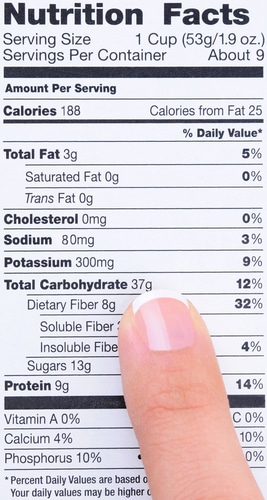 Some of the healthiest foods don’t require a label like fresh fruits and vegetables in the produce aisle – but when you do buy foods and beverages that have nutrition labels, read them thoroughly. Unfortunately, not all consumers take the time to do it. In a study published in the Journal of the American Dietetic Association, researchers found that few shoppers thoroughly read the nutrition label. Instead, they scan the first five lines on the label and use that information to make a decision whether to buy the product or toss it back on the shelf. That’s not a good idea. Here’s why.
Some of the healthiest foods don’t require a label like fresh fruits and vegetables in the produce aisle – but when you do buy foods and beverages that have nutrition labels, read them thoroughly. Unfortunately, not all consumers take the time to do it. In a study published in the Journal of the American Dietetic Association, researchers found that few shoppers thoroughly read the nutrition label. Instead, they scan the first five lines on the label and use that information to make a decision whether to buy the product or toss it back on the shelf. That’s not a good idea. Here’s why.
Why You Should Read Nutrition Labels
Why is it so important to read the nutrition label before buying it? Nutrition labels offer an objective way to evaluate a product – its calorie content, breakdown of macronutrients, how much sodium and fiber it contains and whether it has the worst fat of all – trans-fat. After reading the nutritional breakdown, scanning the ingredient list is the next step. If a product has a long list of ingredients with names you can’t pronounce, think twice before buying it.
Another reason to look through the ingredients is to make sure you don’t see hydrogenated or fractionated oils listed in the ingredients since these are trans-fats. The FDA allows a nutrition label to list “zero grams” of trans-fat if there are less than 0.5 grams per serving, so it’s easy to get fooled by the nutritional label. The problem is ALL trans-fat is bad from a heart health standpoint, even small amounts.
The ingredient list will also tell you whether a product has other “undesirables” like food colorings, MSG and artificial sweeteners. If you have food allergies or are avoiding gluten, it’s critical that you be label savvy and thoroughly read the ingredient list.
Even Healthy Eaters Get Swayed By Food Packaging and Labels
A recent study carried out by researchers at Cornell University shows how easy it is to be swayed by food packaging and why reading the nutrition label is a “must do.” Ever notice how you see so many products packaged in green these days? There’s a reason for that. It seems the color of the label influences how healthy shoppers believe food to be. When they asked young adults to rate the healthiness of two candy bars each with the same calorie content, participants were more likely to rate the candy bar with the green label as being healthful.
In another study carried out online, researchers showed participants images of candy bars with different colored labels. Again, candy bars wrapped in green labels were perceived to be a healthier choice. Interestingly, the more of a premium the participants placed on eating a healthy diet the more likely they were to be swayed by green labels. It seems our brains have been conditioned to believe that “green” is healthy or more natural and food manufacturers are taking advantage of that.
Shoppers can also be swayed by words on labels. For example, in one study, participants ate almost a third more M&Ms when they were labeled as “low fat.” Another study showed shoppers perceive organic foods to be healthier from a nutrition standpoint, although whether an organic designation says nothing about how high the item is in calories, sugar, fat, and sodium. People also underestimate the number of calories in organic products due to the “health halo” that surrounds organic foods and beverages. As a result, they feel less guilty munching on an organic cookie than one without such a label.
The Bottom Line?
Even if you’re health conscious, you can still be influenced by the packaging of a food, its color and buzzwords like “low fat.” Don’t be fooled. When you buy a packaged product, read the nutrition label and ingredient list completely every time. Even better, limit the number of packaged foods you buy and choose more fresh produce and foods that come directly from nature. Be an informed shopper every time you shop – and reap the health benefits.
References:
Science Daily. “Consumers Don’t Pay as Much Attention to Nutrition Fact Labels as They Think, Eye-Tracking Study Finds”
Science Daily. “Green Food Labels Make Nutrition-Poor Food Seem Healthy”
Cornell Food and Brand Lab. “Organic Labels Bias Consumers Perceptions through the “Health halo effect”
Related Articles By Cathe:
5 Ways Nutrition Labels Have Changed
5 Ways Food and Nutrition Labels Mislead You
Nutrition Labels: How They’re Going to Change
How Food Labels Influence Our Food Choices
Nutrition Confusion: How Many People Really Read Nutritional Labels?

